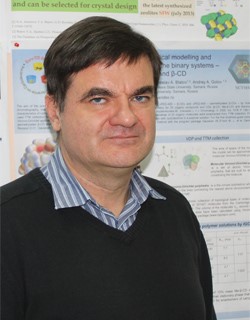5-15、Topological design of new materials: methods, tools, and examples
Vladislav A. Blatov1,2
1Samara Center for Theoretical Materials Science (SCTMS), Samara University, Ac. Pavlov St. 1, Samara 443011, Russia
2School of Materials Science and Engineering, Northwestern Polytechnical University, Xi’an, Shaanxi 710072, People’s Republic of China
摘要:Modern materials science invokes new challenges to researchers in rational design of new compounds, structures and materials. Hence new methods of data processing are needed to make the design as much reliable and predictive as possible. These methods can be implemented in new electronic tools – special software and databases.
At present, a huge amount of experimental information on crystal structures is collected in crystallographic databases, like Cambridge Structural Database, Inorganic Crystal Structure Database, Pearson’s Crystal Data or Powder Diffraction File, a total of more than one million entries. These are the primary data obtained directly in a diffraction experiment in the form of space group, unit cell parameters, atomic coordinates, etc. They are being extended with the data on physical properties of crystalline substances, but these data are also just a result of measurement. At the same time, the primary information contains a lot of hidden regularities, and new tools should be invented to reveal them. With these tools we would be able to transform the crystallographic databases into knowledge databases containing correlations and rules, which then could be used for prediction of new substances and materials. This approach lies in the scope of the Materials Genome program.
In crystal chemistry, the correlations usually have the form ‘chemical composition – structure – physical property’, where the middle term is crucial. Indeed, if chemical composition and physical property can be easily defined, the terms ‘crystal structure’ or ‘local atomic structure’ require specific descriptors. Thus we need to invent as many robust descriptors derived from structural data as possible. Here we consider one of the most important groups of such descriptors, the topological ones. They can be derived from the primary crystallographic data and extend them with the information on the structure connectivity, which is one of the main and natural chemical and crystallochemical characteristics. Topological descriptors can also help one to formalize the classification of crystal structures and search for structural correlations.
We explore how the topological information is derived from the crystallographic data, stored in topological databases and then is used for prediction of crystal structures. All the topological methods and tools used in the analysis were implemented in our program package ToposPro,1 which allows one to process thousands of crystal structure in a proper time. We demonstrate how our software can be applied for both analysis of selected structures of coordination compounds and screening of large crystallographic datasets. Examples from different classes of chemical compounds and materials are presented: ionic substances, intermetallics, ion conductors, microporous materials, coordination polymers, molecular crystals.
The development of hybrid topological-DFT methods for predicting the structure of substances and materials is also discussed. These methods include rapid screening of topological knowledge databases for a qualitative or semi-quantitative prediction and subsequent quantitative calculation of physical properties by DFT methods.
Presenting author email: blatov@topospro.com
参考文献
DOI:10.12110/secondfmge.20181014.515

Vladislav A. Blatov was born in 1965 in Samara (former Kuibyshev), Russia. He graduated from Samara State University (1987) with a honored diploma and received degrees of Candidate (1991) and Doctor in Chemistry (1998) from the Institute of General and Inorganic Chemistry (Moscow). He is Full Professor at the SSU Chemistry Department since 1998 and Director of Samara Center for Theoretical Materials Science (SCTMS) since 2013. He becomes an Adjunct Professor at School of Materials Science and Engineering, Northwestern Polytechnical University, Xi’an, China in 2016. His research and educational interests concern geometrical and topological methods in crystal chemistry and their computer implementation. He is the main developer of the program package TOPOS (now renamed to ToposPro) since 1989. He invented many original algorithms of crystal structure analysis and searching for correlations in crystallographic data. Now he works under development of first knowledge databases and expert systems in crystal chemistry and materials science. He was a tutor and organizer of more than 10 international schools devoted to the ToposPro methods. In 2016 he was recognized by Thomson Reuters as the most cited Russian researcher in chemistry. He has Hirsch index of 37 and about 8,000 citations.
Phone: +7 84 63 35 67 98
Fax: +7 84 63 34 54 17
E-mail: blatov@samsu.ru